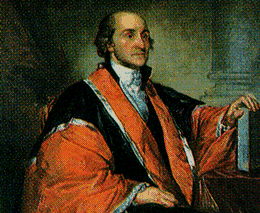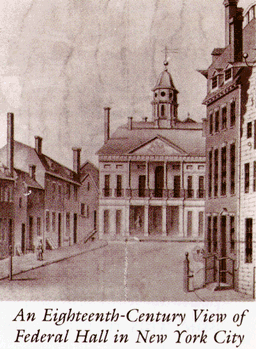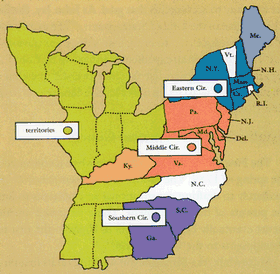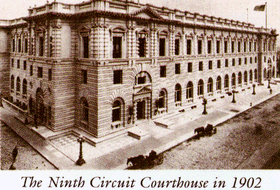Middle District of Louisiana - Baton Rouge
Opening Day - April 16, 1972
Video: 40th Anniversary of the Middle District of Louisiana
Click the link above to see the movie of the formation of the district.

The United States Constitution, which today is the object of praise in this country and which has been copied widely abroad, was the subject of intense controversy when proposed in 1787. Those who favored a strong national government, the Federalists, argued that it was needed to protect the rights of the people. The Anti-Federalists feared that such a government would ride roughshod over those rights.
The judicial provisions of the Constitution were especially controversial. Alexander Hamilton claimed that "the judiciary ... will always be the least dangerous" branch of the proposed national government. Not so, said an Anti Federalist pamphleteer: "We are more in danger of sowing the seeds of arbitrary government in this department than in any other. "
The Constitution contains only a few provisions about the judicial branch. It established the Supreme Court. The framers also took firm steps to keep federal judges independent and to protect them from reprisals for their decisions. In particular, the Constitution provided that the judges would hold office "during good behavior," which gave them a lifetime position rather than a limited term of office. The Constitution also barred Congress from reducing the compensation of federal judges while they remain in office.
However, the Constitution left it to Congress to determine whether there would be any federal trial courts. Why, some people asked, do we need any federal courts besides the Supreme Court? All the states had trial courts, which could decide the country's legal disputes. Many of the Anti-Federalists didn't want another set of courts, especially courts associated with what they saw as a distant national government. They also realized that federal courts would extend national power, which was precisely what the Anti-Federalists wanted to limit.
Once the Constitution was ratified in 1788, the Anti-Federalists sought to have it amended to ensure that the newly established national government could not interfere with such fundamental rights as freedom of expression and religion. They wanted provisions that ensured that no persons would be denied "due process of law," as well as traditional protections of criminal procedure, such as indictment by a grand jury before a criminal trial could be held, and also the right to a lawyer. They also wanted to make it clear that parties to civil suits, as well as parties to criminal cases, could demand jury trials and that higher courts could not overrule a trial jury's factual decisions. The country, they argued, didn't need a set of federal courts; it needed a bill of Alexander Hamilton, one of the leaders of the Federalists, agreed that state courts An Eighteenth-Century View of were "the great cement of Federal Hall in New York City society." But the Federalists weren't willing to have a judicial system composed almost exclusively of state courts. They argued that a federal court system would create conditions for the new nation's commercial growth, which the Articles of Confederation had been unable to provide.
All the factions agreed with the goal in the Constitution's preamble—"to establish justice." But they disagreed over the best way to accomplish that goal. As John Jay, the first Chief Justice of the United States, put it, "The expediency of carrying justice . . . to every man's door was obvious," but "how to do it in an expedient manner was far from apparent." The framers left the controversial question of whether and how to set up lower level federal courts to the First Congress.

Establishing the Federal Courts
The First Congress did two things when it convened in the spring of 1789. The House of Representatives set immediately to drafting constitutional amendments to limit the powers of the government. These proposed amendments eventually became the Bill of Rights—the first ten amendments to the Constitution.
Meanwhile, the Senate began working on its first piece of legislation, Senate Bill 1, which became "An Act to Establish the Judicial Courts of the United States." President Washington signed this first Judiciary Act into law on September 24, 1789, thus creating the federal court system. Most of the specific provisions in the Judiciary Act have long since been replaced or modified, but the federal court system still embodies the Act's basic principles.

Judicial Circuits Of the United States in 1789
Rhode Island and North Carolina had not yet ratified the Constitution. Vermont had not yet joined the Union. Maine, still part of Massachusetts, and Kentucky, still part of Virginia, were formed into separate judicial districts, not included in any circuit.
The Act was a compromise. For those in favor of national power, it created federal courts in addition to the Supreme Court—three circuit courts for major trials and thirteen district courts for less important cases. Parties could appeal some district court decisions to the circuit courts and some circuit court decisions to the Supreme Court. The Act authorized the district courts to resolve disputes arising on the seas; maritime commerce was the lifeblood of the new nation's economy, and even the Anti-Federalists agreed that federal courts should decide these admiralty cases. The Act established the "diversity of citizenship" jurisdiction that Anti-Federalists feared, permitting suits between citizens of different states to be brought in federal court. It also authorized federal courts to try persons accused of certain federal crimes and to hear petitions from federal prisoners asking federal courts to issue writs of habeas corpus. The Act authorized the United States government to bring lawsuits in federal court and it gave the Supreme Court jurisdiction to hear appeals from state court cases involving the Constitution or federal laws.
The 1789 Judiciary Act was hardly a total victory for the Federalists. It limited the federal courts in many ways not required by the Constitution. The Act did not even grant the district and circuit courts what is now known as "federal question" jurisdiction. Therefore, cases based on the Constitution or on most civil statutes passed by Congress would be decided in the state courts. The states were an important point of reference for the new federal court system: The Act directed the federal courts to use state laws in the absence of federal law to the contrary and used state boundaries as the boundaries for the district and circuit courts.
Thus, under the design of the Constitution as complemented by the first Judiciary Act, federal courts would try federal crimes, admiralty cases, lawsuits by the United States, lawsuits between citizens of different states, and a few other matters. The state courts would continue to do the great bulk of judicial work. The Supreme Court was available to correct errors in federal courts and in state courts in certain kinds of cases. With some important changes, this is
largely how the system operates today.
Reorganizing the System
Some aspects of the early judicial system seem anomalous today. For example, it required the justices of the Supreme Court to serve also as circuit court judges. In order to do so, the justices had to travel to and around their assigned circuits, trying cases with the district judges. Congress thought this would let the highest judges of the land be seen by the people, and let the justices see the daily workings of the courts.
Almost immediately, the justices began to complain about circuit riding. Travel was difficult, accommodations were often uncomfortable, and the justices were separated from their families for long periods of time. Congress was slow to change the system. The justices' protests grew louder as the country grew and circuit duty became more arduous. Congress made one concession to the justices: when it created an additional circuit, it added another justice to the Supreme Court who would also serve as the justice for the new circuit. Thus, the Supreme Court grew as the country grew. By 1862, it included ten justices, one more than it has now.
Even though circuit riding by the justices was gradually curtailed, the Supreme Court's workload increased, and case backlogs at all levels of the federal court system grew to alarming proportions. After the Civil War, constitutional amendments and federal laws passed to protect the newly freed slaves added more cases to the federal courts' dockets; new laws to promote business growth did the same. In 1867, Congress extended federal court jurisdiction to hear habeas corpus petitions from prisoners convicted in state courts who claimed that their constitutional rights had been violated at trial. In 1875, Congress finally gave the federal trial courts general "federal question" jurisdiction. No longer would most cases arising under federal statutes have to be tried in the state courts as they were under the 1789 Judiciary Act. This change increased the federal caseload still further.
The Supreme Court was now overloaded with appeals from the federal trial courts and the state courts. Many complained that federal trial courts exercised unbridled power because, as a practical matter, there was little opportunity to have their decisions reviewed by the Supreme Court.
Congress did not act until 1891, when it relieved the Supreme Court justices of any obligation to "ride circuit" and began to reduce the categories of cases that the Court was required to decide. Further, Congress significantly reorganized the federal courts by creating a separate set of courts--the circuit courts of appeals— to hear appeals from the federal trial courts. The district courts became the major federal trial| courts, and the old circuit courts created by the 1789 Judiciary Act were phased out. This three-tiered system of district courts, courts of appeals, and the Supreme Court remains the structure of the federal judicial system today.
The Federal Courts in American History
Since 1789, the federal judiciary has grown from 13 district judges and 6 Supreme Court justices to over 550 district judges and 160 courts of appeals judges, as well as the 9 justices on the Supreme Court. In these 200 years, the federal courts have played a vital role in the national life, developing important legal principles in the course of resolving individual disputes. Their business in different periods reflected the pressing national problems of those times.

In the nineteenth century, decisions by the circuit courts and the Supreme Court helped create a climate for investment, commercial enterprise, and industrialization. Before the Civil War, federal! courts were caught up in the controversy over whether fugitive slaves could be returned to their "owners" in the slave states from which they had fled. After the Civil War, the federal courts were called upon to interpret the civil rights statutes passed to protect the citizens newly freed from slavery.
Today, federal courts decide cases involving economic regulatory statutes and orders issued by administrative agencies. They hear cases based on charges of racial or other arbitrary discrimination, as well as disputes over bankruptcy, patents, copyrights, and admiralty matters. Their dockets also cover the whole range of federal criminal laws. And, as they have for 200 years, they decide cases involving state law between citizens of different states.
As the founders anticipated, federal judges' insulation from public reprisal has permitted them to make unpopular decisions: when required by the Constitution, often protecting minority rights or the expression of unorthodox beliefs. When necessary, the federal courts have been the arbiter between the executive and legislative branches of government, holding each to its constitutional sphere.
By carrying out these judicial responsibilities, the federal courts reflect the commitment of the American people to the rule of law.
For Further Reading:
Felix Frankfurter & James Landis. The Business of the Supreme Court. New York: Macmillan, 1928.
Julius Goebel, Jr. Ch. XI, "The Judiciary Act of 1789," in Antecedents and Beginnings to 1800, vol. I of The History of the Supreme Court (Oliver Wendell Holmes Devise History of the Supreme Court of the United States). New York: Macmillan, 1971.
Herbert J. Storing. What the Anti-Federalists Were For. Chicago: University of Chicago Press, 1981.
Welcome to the Federal Court and Federal Courts and What They Do. Washington, D.C.: Federal Judicial Center, 1987
(pamphlet and brochure, respectively, available at the federal courthouse).
This web page was created from a pamphlet created by The Committee on the Bicentennial of the Constitution of the Judicial Conference of the United States, Hon. Damon J. Keith, chairman. The pamphlet was created in cooperation with the Special Educational Services Division of the Federal Judicial Center, to promote understanding of the history of the federal courts during the 200th anniversary of their creation. The Judicial Conference is the administrative governing body for the federal court system. The Federal Judicial Center is the federal courts' agency for research, development, and continuing education. The preparation of the pamphlet was supervised by the Honorable Dolores K. Sloviter, United States Court of Appeals for the Third Circuit, a member of the committee, and Russell R. Wheeler, Director, Special Educational Services Division, Federal Judicial Center.
First photo: Chief Justice John Jay was 44 years old in February 1790, when he convened the opening session of the United States Supreme Court. He had already had an impressive career. He had represented New York in the Continental Congress that declared war on Great Britain; with Benjamin Franklin and John Adams, he negotiated the treaty of Paris that ended that war. He was secretary of foreign affairs under the Articles of Confederation, but a strong supporter of the Constitution as a replacement for the weak effort at a government.
Picture credits:
Map of the circuits: Federal Judicial Center; John Jay: Portrait by Gregory Stapko after Gilbert Stuart, Collection of the Supreme Court of the United States, Washington, D.C.; Ninth Circuit Courthouse: Pacific Sierra Field Branch, National Archives and Records Administration, San Bruno, California, and Ninth Judicial Circuit Historical Society, Pasadena, California.

